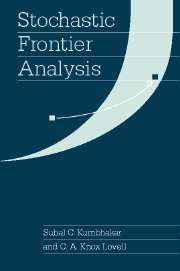Book contents
- Frontmatter
- Contents
- Preface
- 1 Introduction
- 2 Analytical Foundations
- 3 The Estimation of Technical Efficiency
- 4 The Estimation and Decomposition of Cost Efficiency
- 5 The Estimation and Decomposition of Profit Efficiency
- 6 The Shadow Price Approach to the Estimation and Decomposition of Economic Efficiency
- 7 Incorporating Exogenous Influences on Efficiency
- 8 The Estimation of Efficiency Change and Productivity Change
- References
- Author Index
- Subject Index
7 - Incorporating Exogenous Influences on Efficiency
Published online by Cambridge University Press: 05 June 2012
- Frontmatter
- Contents
- Preface
- 1 Introduction
- 2 Analytical Foundations
- 3 The Estimation of Technical Efficiency
- 4 The Estimation and Decomposition of Cost Efficiency
- 5 The Estimation and Decomposition of Profit Efficiency
- 6 The Shadow Price Approach to the Estimation and Decomposition of Economic Efficiency
- 7 Incorporating Exogenous Influences on Efficiency
- 8 The Estimation of Efficiency Change and Productivity Change
- References
- Author Index
- Subject Index
Summary
INTRODUCTION
The analysis of productive efficiency has, or at least should have, two components. The first is the estimation of a stochastic production (or cost or profit or other) frontier that serves as a benchmark against which to estimate the technical (or cost or profit or other) efficiency of producers. Thus the objective of the first component is to estimate the efficiency with which producers allocate their inputs and their output(s), under some maintained hypothesis concerning behavioral objectives. This first component is by now reasonably well developed, and has been the subject of our investigation in Chapters 3–6.
The second component is equally important, although much less frequently explored. It concerns the incorporation of exogenous variables, which are neither inputs to the production process nor outputs of it, but which nonetheless exert an influence on producer performance. The objective of the second component is to associate variation in producer performance with variation in the exogenous variables characterizing the environment in which production occurs. Examples include the degree of competitive pressure, input and output quality indicators, network characteristics, ownership form, various managerial characteristics, and the like. We have been deliberately vague about the specific role of the exogenous variables in explaining producer “performance.” They may influence the structure of the technology by which conventional inputs are converted to output(s), or they may influence the efficiency with which inputs are converted to output(s).
- Type
- Chapter
- Information
- Stochastic Frontier Analysis , pp. 261 - 278Publisher: Cambridge University PressPrint publication year: 2000



